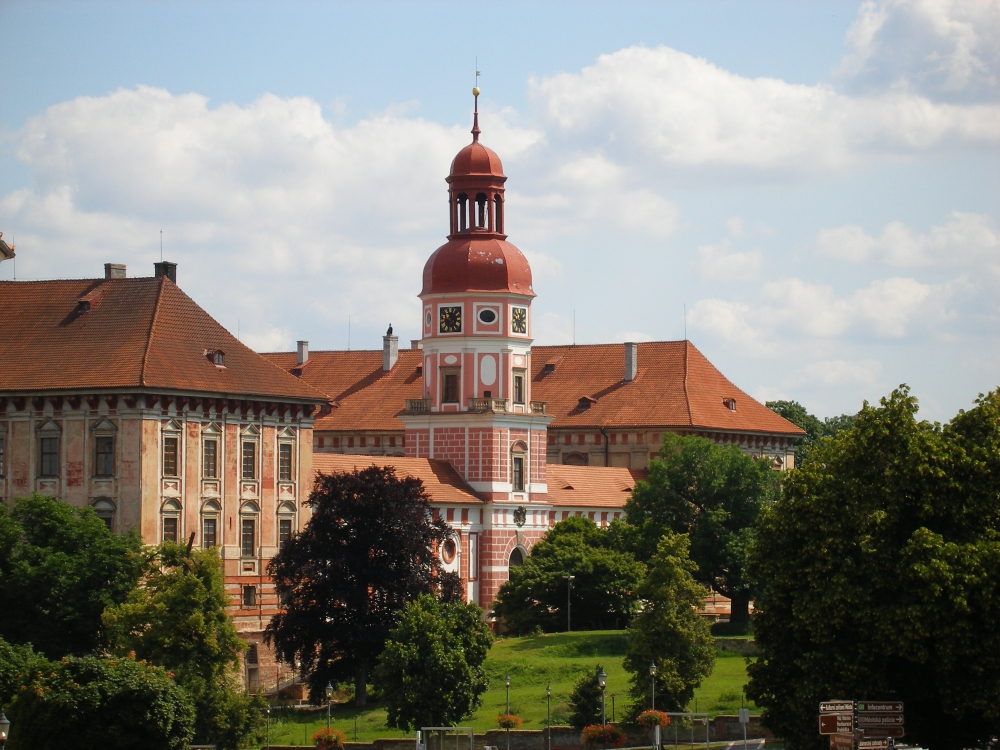Elbe cycle route in the Garden of Bohemia
Hněvice - Litoměřice
The section of the Elbe cycle route between Stětí and Litoměřice is approximately 30 km long and runs partly as a cycle path and partly on Class II and III roads. Part of the route (between Roudnice nad Labem and Litoměřice) runs along both banks of the Elbe.
The main tourist attractions along the route are the Lobkowicz Castle in Roudnice nad Labem, the fortress town of Terezín or the nearby Říp Mountain, which is reached by cycle route No. 3102.
Map of the cycle path - Hněvice - Litoměřice
Tourist destinations
The famous rowing course in Račice was built on the place of the former sand-mine and it was finished in 1986. The canal can host rowing races up to 2000 meters. There is a 5-kilometre-long road around the whole canal and the total area of the grounds is 73 hectares. Labe Arena is a place for many kinds of water sports, like rowing, canoeing, dragon boats, and other sports such as bowling, in-line skating, fishing, cycling, triathlon, beach volleyball, aerobic, and model ships.

Dobříň Village is located about 5 kilometres from Roudnice nad Labem town. The first written document about this village comes from the end of the 13th century. Today, the population of Dobříň is about 550 inhabitants. In Dobříň, you can visit the birthplace of a poet Josef Hora. In his house, there is a small exhibition about the poet’s life. Not far from the village, there is a natural reservation called Dobříňský háj (The Dobříň Forest) - the floodplain forest of the Labe river. There you can see some rare and protected plants (for example the snowdrop shooter), and insects. Another notable feature of Dobříň village is the Dobříň lake. Today, the former sand mine is a natural swimming pool

The town of Roudnice nad Labem is situated on the left bank of the river Labe in the fertile Central Labe Lowland. The first written remarks about the town come from the second half of the 12th century. The population of the town is over 13 thousand inhabitants. The history of the town is very rich, starting from the marks of prehistoric settlements found near the former ford across Labe. It is one of the oldest Czech towns. There are several monuments and sights worth visiting in Roudnice: the Lobkowitz chateau and the Romanesque castle (both open to public), the lookout tower Hláska, The Church of Our Lady’s Birth and the neighbouring Augustinian Monastery, St. Joseph’s Chapel, The Modern Art Gallery, The Museum of the Říp Region, and many more.

The Říp Mountain (456 metres above the sea level) stands out of the Central Labe Lowland 5 kilometres south of Roudnice nad Labem. On its top, there is the rotunda of St. Geogre and St. Vojtěch. Inside, you can see the statue of St. George and The Dragon. Several marked trails go up to the top of the mountain. From the viewpoints on the top of the hill, for example Mělník, Prague, or Roudnice Viewpoint, you can see panoramic views of distant places like the Central Bohemian Highlands or the deep woods of the Kokořín Region. In 1907, a tourist cabin was built next to the rotund. You can still stop and get some refreshments there.

The town Terezín is situated near the junction of Labe and Ohře rivers was founded as a fort in 1780, during the reign of the Emperor Joseph II. It was built with the aim to protect the Czech borders against an attack from the north. It was once a jewel of the Northern Bohemian region, but now it is more famous for the sad events of World War II. You can learn about the history of the town and the fort at the exhibition in the Retranchement 5, where the visitors centre is located. Apart from that, you can take a walk on the fortification walls or take a guided tour down the underground corridors. The most important reminder of World War II is the Terezín Memorial in the Small Fort. You can also visit the Terezín Riding School, The Ghetto Museum, The Terezín Car Museum and many more.

The real pearl among the chateaus of the Northern Bohemia is the Ploskovice chateau near Litoměřice. It was built between 1720 and 1730 by Anna Marie Františka of Toscany, then wife of the last descendant of the famous Italian noble family – Medici. The original summer residence was rebuilt in the late Baroque style by Kilián Ignác Dietzenhofer. At the beginning of the 19th century, the chateau became the property of the Habsburg family. The emperors Ferdinand V and Franz Joseph I both used Ploskovice as their summer residence. After Czechoslovakia was established in 1918, it became the summer seat of the Foreign Ministry. It was often visited by Edvard Beneš and his wife. We recommend the tour round the castle and the walk through its gardens with Baroque style fountain and grotto (artificial cave) to any visitor of the Central Bohemian Highlands.















